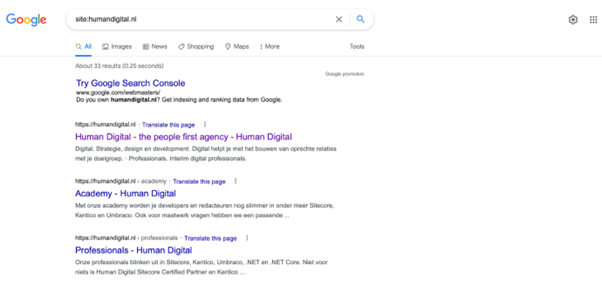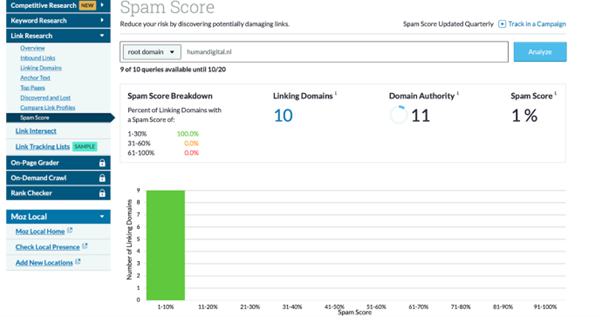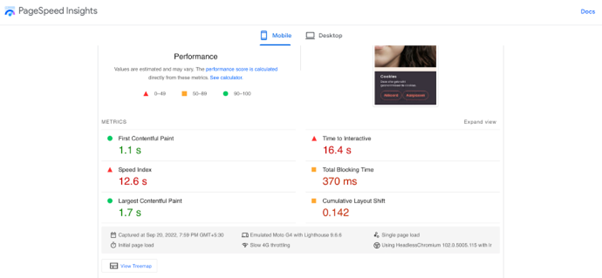A comprehensive guide to SEO analysis in eight steps

An SEO analysis, or Search Engine Optimization analysis, helps determine how to improve a website's position in search engine results. The ultimate goal is to increase organic (non-paid) traffic to the website.
How to conduct a website SEO analysis?
Step 1: Assess your Google visibility
Begin by understanding your current position in search engines. This initial step reveals how many of your website's webpages have been successfully indexed by Google. A quick way to do this is by typing site:websiteurl into Google's search bar to display all indexed pages. For example site:humandigital.nl.

Step 2: Review your URLs and meta descriptions
Evaluate all URLs and their corresponding meta descriptions for each individual webpage. Ensure URLs are concise and relevant. Optimize meta descriptions by incorporating primary and secondary keywords while clearly summarizing the page's content.

Step 3: Evaluate your backlinks
Backlinks are hyperlinks to your site from another website. The more backlinks you have, the more credible your website appears to search engines. If your website lacks sufficient backlinks, consider reaching out to influencers or relevant websites within your niche to acquire them. Numerous online tools, some even free, can aid in backlink research, such as SmallSEO.

Step 4: Check your spam score
No one likes spam, including search engines. Your spam score increases if your website contains links from low domain authority websites. Improve your spam score by removing spammy backlinks. Use tools like Moz's Link Research tool, which provides instant spam score insights.

Step 5: Identify broken links
Broken links (incorrect URLs) significantly impact user experience, disliked by both users and Google. Websites with broken links receive lower rankings. Detect and fix broken links using tools like Dr. Link Check, which provides a comprehensive report on good versus broken links.

Step 6: Audit content
Visitors engage with your website due to its high-quality and informative content. Avoid overwhelming them with irrelevant or duplicate information, as this leads to poor user experience and potential Google penalties. Resolve content issues or temporarily remove problematic pages to enhance your SEO score.
Step 7: Optimize images
Search engine bots cannot crawl images. Therefore, provide each image with a Title and Alt Title. Additionally, compress all images before uploading to improve page load times.
Step 8: Evaluate site loading speed
Lastly, assess your website's loading speed. A faster loading website enhances user experience, thereby improving SERP rankings. Utilize Google's free PageSpeed Insights Tool to measure your website's speed.

Top 5 SEO-trends for 2023
1. Search intent
Align your content precisely with user search intent. Ensure your published content directly meets what users are searching for to avoid penalties for irrelevant keywords.
2. Keyword clusters
Shift focus from individual keywords to clusters of related keywords. For example, if your primary keyword is "shirts," include secondary keywords like "flannel shirt" and "branded shirt" to broaden your audience reach and improve SERP rankings.
3. Video content
Integrate video content into your SEO strategy to cater to impatient users. Optimize video descriptions with relevant keywords to enhance visibility.
4. Voice search optimization
As voice assistants like Siri and Alexa gain popularity, optimize your website for voice search queries. Consider semantic and conversational context to align content with spoken queries.
5. Mobile-first experience
Given the increasing role of smartphones, ensure your website provides an excellent mobile experience. Google's mobile-first indexing prioritizes mobile-friendly websites, impacting search engine rankings.
Conclusion
You now possess the foundational knowledge of conducting an SEO analysis and understanding key SEO trends for 2023 and beyond. Follow the steps outlined above to perform an SEO analysis of your website, identify and resolve issues before they affect your Google rankings. Embrace the trends highlighted in this article to maintain a competitive edge in search engine rankings. Good luck!